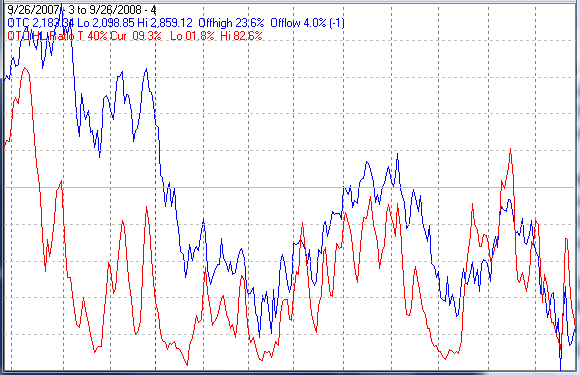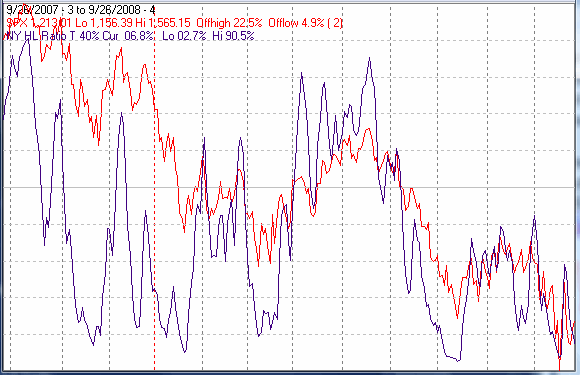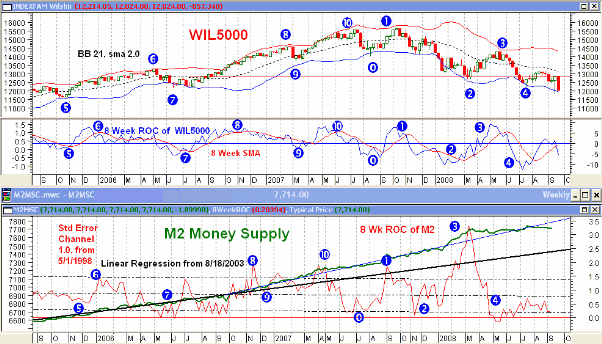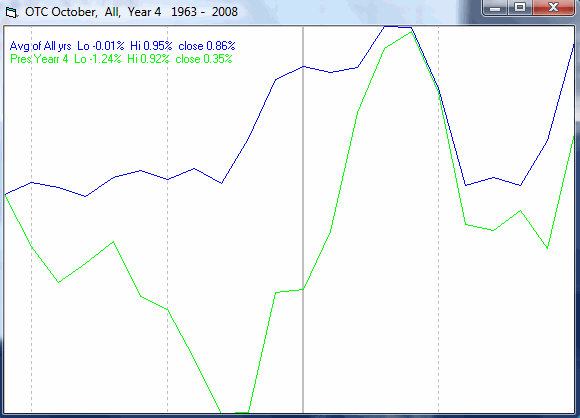Baillout Plan Deal to Ignite Stock Market End Quarter Rally
Stock-Markets / US Stock Markets Sep 28, 2008 - 08:46 AM GMTBy: Mike_Burk
The good news is: A bottom is near.
Short Term When, speaking of the economy, the President declares "This sucker is going down", short term indicators lose their relevance.
Intermediate Term The high number of new lows a week ago imply a high likelihood of a retest of the September price low.
The chart below covers the past year showing the NASDAQ composite (OTC) in blue and a 40% trend (4 day EMA) of NASDAQ new highs divided by new highs + new lows in red. Dashed horizontal lines have been drawn at 10% levels for the indicator with a solid line at the 50% level. Dashed vertical lines have been drawn on the 1st trading day of each month.
The history of this indicator began in 1978, when the current method of calculating new highs and new lows was adopted. The indicator fell below the 50% level around November 1st last year and remained there until mid August, a record. Currently the indicator is at a very low level and falling.

The next chart is similar to the one above except it shows the S&P 500 (SPX) in red and the ratio calculated from NYSE data in black. The indictor calculated from NYSE data has been a little stronger, but, like the above chart, the indicator is at a low level and falling.

Seasonality
Next week includes the last 2 trading days of September and the 1st 3 trading days of October during the 4th year of the Presidential Cycle.
The tables show the daily return on a percentage basis for the last 2 trading days of September and the 1st 3 trading days of October during the 4th year of the Presidential Cycle. OTC data covers the period from 1963 - 2007 and SPX data from 1928 - 2007. There are summaries for both the 4th year of the Presidential Cycle and all years combined.
On average the OTC has been flat over the coming week while the SPX has been positive.
Report for the Last 2 days of September and first 3 days of October.
The number following the year represents its position in the presidential cycle.
The number following the daily return represents the day of the week;
1 = Monday, 2 = Tuesday etc.
| OTC Presidential Year 4 | ||||||
| Day2 | Day1 | Day1 | Day2 | Day3 | Totals | |
| 1964-4 | 0.00% 2 | 0.26% 3 | 0.09% 4 | -0.25% 5 | 0.07% 1 | 0.16% |
| 1968-4 | -0.08% 5 | -0.04% 1 | 0.20% 2 | 0.61% 4 | 0.37% 5 | 1.05% |
| 1972-4 | 0.45% 4 | 0.37% 5 | -0.24% 1 | 0.14% 2 | -0.15% 3 | 0.58% |
| 1976-4 | -0.40% 3 | -0.01% 4 | -0.90% 5 | 0.02% 1 | -0.78% 2 | -2.08% |
| 1980-4 | -2.61% 1 | 1.06% 2 | 0.99% 3 | 0.63% 4 | 1.37% 5 | 1.44% |
| 1984-4 | 0.02% 4 | -0.14% 5 | -0.83% 1 | -0.71% 2 | -0.52% 3 | -2.18% |
| Avg | -0.52% | 0.25% | -0.16% | 0.14% | 0.06% | -0.24% |
| 1988-4 | 0.72% 4 | 0.43% 5 | -0.83% 1 | -0.07% 2 | 0.08% 3 | 0.33% |
| 1992-4 | 0.40% 2 | 0.98% 3 | -0.85% 4 | -1.16% 5 | -1.12% 1 | -1.75% |
| 1996-4 | 0.17% 5 | -0.26% 1 | -0.44% 2 | 1.20% 3 | -0.23% 4 | 0.43% |
| 2000-4 | 3.34% 4 | -2.79% 5 | -2.83% 1 | -3.17% 2 | 1.95% 3 | -3.51% |
| 2004-4 | 1.29% 3 | 0.15% 4 | 2.39% 5 | 0.53% 1 | 0.16% 2 | 4.52% |
| Avg | 1.18% | -0.30% | -0.51% | -0.54% | 0.17% | 0.00% |
| OTC summary for Presidential Year 4 1964 - 2004 | ||||||
| Averages | 0.30% | 0.00% | -0.30% | -0.20% | 0.11% | -0.09% |
| % Winners | 64% | 55% | 36% | 55% | 55% | 64% |
| MDD 10/3/2000 8.54% -- 10/5/1992 3.10% -- 9/29/1980 2.61 | ||||||
| OTC summary for all years 1963 - 2007 | ||||||
| Averages | 0.04% | -0.12% | 0.04% | -0.01% | 0.08% | 0.03% |
| % Winners | 50% | 49% | 55% | 58% | 58% | 56% |
| MDD 10/5/1998 11.64% -- 10/3/2000 8.54% -- 10/3/1974 5.18% | ||||||
| SPX Presidential Year 4 | ||||||
| Day2 | Day1 | Day1 | Day2 | Day3 | Totals | |
| 1928-4 | 0.05% 5 | 1.09% 6 | -0.05% 1 | -0.47% 2 | -0.33% 3 | 0.29% |
| 1932-4 | -3.11% 4 | -0.25% 5 | 0.87% 6 | -1.10% 1 | -0.12% 2 | -3.72% |
| 1936-4 | -0.43% 2 | -0.31% 3 | 0.19% 4 | 1.93% 5 | 0.98% 6 | 2.35% |
| 1940-4 | 0.66% 6 | 0.09% 1 | 1.41% 2 | 0.46% 3 | 0.09% 4 | 2.72% |
| 1944-4 | 0.39% 5 | 0.31% 6 | 0.16% 1 | 0.00% 2 | 0.55% 3 | 1.41% |
| Avg | -0.49% | 0.19% | 0.51% | 0.16% | 0.23% | 0.61% |
| 1948-4 | 1.24% 3 | -0.39% 4 | 1.16% 5 | 0.51% 6 | 0.63% 1 | 3.16% |
| 1952-4 | -0.20% 1 | -0.57% 2 | -0.24% 3 | 0.16% 4 | -0.08% 5 | -0.93% |
| 1956-4 | -0.48% 4 | -0.55% 5 | -1.43% 1 | 1.83% 2 | 1.67% 3 | 1.04% |
| 1960-4 | 0.27% 4 | 1.71% 5 | -0.30% 1 | -0.69% 2 | 0.75% 3 | 1.74% |
| 1964-4 | -0.05% 2 | -0.07% 3 | -0.12% 4 | 0.33% 5 | 0.45% 1 | 0.55% |
| Avg | 0.15% | 0.03% | -0.19% | 0.43% | 0.69% | 1.11% |
| 1968-4 | -0.05% 5 | 0.35% 1 | 0.19% 2 | 0.47% 4 | 0.36% 5 | 1.31% |
| 1972-4 | 0.63% 4 | 0.18% 5 | -0.35% 1 | 0.13% 2 | -0.19% 3 | 0.39% |
| 1976-4 | -0.52% 3 | -0.12% 4 | -1.02% 5 | -0.13% 1 | -0.77% 2 | -2.56% |
| 1980-4 | -2.22% 1 | 1.55% 2 | 1.33% 3 | 0.76% 4 | 0.97% 5 | 2.38% |
| 1984-4 | 0.41% 4 | -0.52% 5 | -0.89% 1 | -0.63% 2 | -0.70% 3 | -2.33% |
| Avg | -0.35% | 0.29% | -0.15% | 0.12% | -0.07% | -0.16% |
| 1988-4 | 1.30% 4 | -0.25% 5 | -0.19% 1 | -0.28% 2 | 0.46% 3 | 1.04% |
| 1992-4 | 0.04% 2 | 0.24% 3 | -0.36% 4 | -1.40% 5 | -0.71% 1 | -2.18% |
| 1996-4 | 0.05% 5 | 0.17% 1 | 0.26% 2 | 0.71% 3 | -0.18% 4 | 1.01% |
| 2000-4 | 2.22% 4 | -1.49% 5 | -0.02% 1 | -0.68% 2 | 0.55% 3 | 0.58% |
| 2004-4 | 0.43% 3 | -0.02% 4 | 1.52% 5 | 0.32% 1 | -0.06% 2 | 2.19% |
| Avg | 0.81% | -0.27% | 0.24% | -0.26% | 0.01% | 0.53% |
| SPX summary for Presidential Year 4 1928 - 2004 | ||||||
| Averages | 0.03% | 0.06% | 0.10% | 0.11% | 0.22% | 0.52% |
| % Winners | 60% | 45% | 45% | 55% | 55% | 75% |
| MDD 10/4/1932 3.71% -- 10/3/1984 2.71% -- 10/5/1976 2.54% | ||||||
| SPX summary for all years 1928 - 2007 | ||||||
| Averages | -0.13% | -0.06% | 0.13% | 0.21% | 0.14% | 0.28% |
| % Winners | 54% | 47% | 50% | 68% | 52% | 63% |
| MDD 10/3/1931 10.76% -- 10/3/1974 6.29% -- 10/1/1998 5.97% | ||||||
Money supply (M2)
The chart below was provided by Gordon Harms. Money supply growth has fallen below the elevated trend of the past 2 years. With all of the government bailouts, money supply should grow noticeably over the next few weeks.

October
Since 1963, over all years, the OTC has been up 59% of the time in October with an average gain of 1.0%, however, during the 4th year of the Presidential Cycle it has been up only 50% of the time with an average gain of 0.2%.
The average month has 21 trading days. The chart below has been calculated by averaging the daily percentage change of the OTC for each of the 1st 11 trading days and each of the last 10. In months when there were more than 21 trading days some of the days in the middle were not counted. In months when there were less than 21 trading days some of the days in the middle of the month were counted twice. Dashed vertical lines have been drawn after the 1st trading day and at 5 trading day intervals after that. The line is solid on the 11th trading day, the dividing point.
The blue line shows the average of all years since 1963 while the green line shows the average during the 4th year of the Presidential Cycle.

Since 1928, over all years, the SPX has been up 60% of the time in October with an average gain of 0.3%, during the 4th year of the Presidential Cycle it has been up 75% of the time (2nd only to December at 80%) with an average gain of 0.6%
The next chart is similar to the one above except it uses SPX data from 1928.

On average there has been a low during the 2nd week of October during the 4th year of the Presidential Cycle. The possibility of that occurring this year is not far fetched.
Conclusion
My guess is the short selling ban and panic to get a bailout in place is related to the end of the quarter. An announcement of a solution will send stocks up through Tuesday, the end of the quarter. The political need to keep stocks up ends with the quarter and the short selling ban ends Thursday. Next week will be interesting.
I expect the major indices to be higher on Friday October 3 than they were on Friday September 26.
Last weeks positive forecast was a miss.
Thank you,
By Mike Burk
To subscribe to this report : http://alphaim.net/signup.html
Gordon Harms produces a Power Point for our local timing group. You can get a copy of that at: http://www.stockmarket-ta.com/ .
Disclaimer: Mike Burk is an employee and principal of Alpha Investment Management (Alpha) a registered investment advisor. Charts and figures presented herein are believed to be reliable but we cannot attest to their accuracy. Recent (last 10-15 yrs.) data has been supplied by CSI (csidata.com), FastTrack (fasttrack.net), Quotes Plus (qp2.com) and the Wall Street Journal (wsj.com). Historical data is from Barron's and ISI price books. The views expressed are provided for information purposes only and should not be construed in any way as investment advice. Furthermore, the opinions expressed may change without notice.
Mike Burk Archive |
© 2005-2022 http://www.MarketOracle.co.uk - The Market Oracle is a FREE Daily Financial Markets Analysis & Forecasting online publication.




